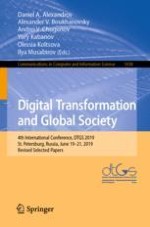2019 | Book
Digital Transformation and Global Society
4th International Conference, DTGS 2019, St. Petersburg, Russia, June 19–21, 2019, Revised Selected Papers
Editors: Daniel A. Alexandrov, Alexander V. Boukhanovsky, Dr. Andrei V. Chugunov, Yury Kabanov, Olessia Koltsova, Ilya Musabirov
Publisher: Springer International Publishing
Book Series : Communications in Computer and Information Science
